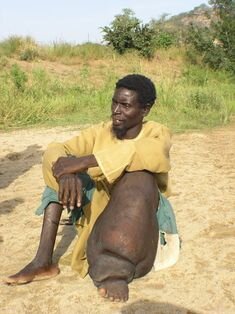The health and economic impact of the Global Programme to Eliminate Lymphatic Filariasis

Following the publication of their article on the health and economic benefits of the Global Programme to Eliminate Lymphatic Filariasis, co-authors Hugo Turner and Alison Bettis spoke to BioMed Central about their research.
Lymphatic filariasis (LF), which causes elephantiasis, is a neglected tropical disease (NTD). Before wide-spread control, approximately 120 million people worldwide were infected with this disease, with 40 million suffering from overt clinical disease. Clinical disease associated with lymphatic filariasis significantly reduces economic productivity, as well as limiting educational and employment opportunities.
In 2000, the World Health Organization (WHO) established the Global Programme to Eliminate Lymphatic Filariasis (GPELF), with th e goal of eliminating the disease as a public health problem by 2020.
Between 2000 and 2014, the GPELF has delivered 5.6 billion treatments to over 763 million people. Understanding the impact of the GPELF, particularly by estimating health and economic benefits of the programme, is important in justifying the significant resources that continue to be invested in the elimination of lymphatic filariasis.
What we did
In collaboration with other researchers and experts in lymphatic filariasis control at Emory University, the Neglected Tropical Diseases Support Center at the Task Force for Global Health and GlaxoSmithKline we undertook a project which provides updated estimates of the health and economic benefits of the GPELF from 2000 to 2014. We did this by combining previously established models that estimate the number of clinical cases and disability-adjusted life years (DALYs) averted as a result of the GPELF.
We also estimated the economic savings associated with clinical disease prevention. These include:
- Prevented medical expenses incurred by patients,
- Potential individual income loss, through lost-labour resulting from lymphatic filariasis clinical symptoms/sequelae; and
- Prevented costs to the health system, for care/treatment of LF patients
The estimated health impact
We projected that 36 million chronic cases will be averted as a result of the first 15 years of the GPELF. This corresponds to 175 million DALYs being averted over the full lifetime of those who have received treatment through the GPELF.
The estimated economic impact
We estimate that, as a result of the first 15 years of the GPELF, 46 million individuals will experience economic benefits due to prevented clinical disease. Individuals treated through the GPELF are estimated to save a combined total of US$96.9 billion (an average of US$2,095 per person) over their lifetime, income that would have otherwise been lost due to inability to work and medical expenses. This is equivalent to the income earned from working 33.3 days (or 11% of their average annual income).
In addition to the economic benefits to individuals, we projected US$3.5 billion in health system costs will be saved in endemic areas. Such savings are critical for health systems in resource-poor settings.
The total economic impact (for both individuals and health systems) is estimated to be US$100.5 billion.
Additional benefits
In addition to the health and economic benefits discussed above, the GPELF has had a sizeable impact on quality-of-life at the individual level through amelioration of debilitating, disabling, and stigmatising symptoms.
The GPELF has also likely had a significant impact on the control of co-endemic diseases (such as the soil-transmitted helminths (STH) and scabies) which are sensitive to drug use – meaning that the total health and economic value of the GPELF is likely even greater than what is presented here.
Key messages
This study quantifies and presents the substantial health and economic benefits that have resulted from the first 15 years of the GPELF. Our results further highlight the value and importance of continued investment in the GPELF, as additional resources will be necessary to assist the remaining countries in implementing programmes for lymphatic filariasis elimination.
Though this analysis used a number of assumptions (as with any model), we attempted to be conservative in our approach and believe the results to be representative of the significant positive impact of the GPELF from 2000-2014.
Read the Research
Hugo C Turner, Alison A Bettis, et al. The health and economic benefits of the global programme to eliminate lymphatic filariasis (2000–2014), Infectious Diseases of Poverty
Source - BioMed Central